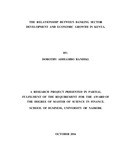| dc.description.abstract | Kenya as at end of December 2015, which has a population of 44 million people is served by forty two commercial banks, twelve microfinance banks and one mortgage finance company, offices of foreign bank representative are 8, 79 foreign exchange bureaus, and bureaus of credit reference are 3, all these constitute banking sector in Kenya. In a small comparison, while Kenya has 44 million people served by 42 commercial banks, compared with Nigeria that has 22 banks that serves 180 million populaces, while South Africa has 19 commercial bank that also serve 55 million.
There are various sectors that determine the economic growth of any particular country, therefore the study strived to establish the affiliation between banking sector improvement indicators such as sector assets, sector customer deposits as well as sector liquid liabilities and the real economic growth in Kenya. The study evidenced that a correlation of banking segment and economic growth in Kenya exist at a very weak level. The data was collected from published secondary sources from KNBS and CBK quarterly from 2005 to 2015. I analysed the data using SPSS version 20. In this study, various sector actors like financial assets indicates that a minimal positive statistical estimated relationship exist with economic growth, again at the correlation of coefficient, the study explains that every 2.438 million Kenya shillings invested in banking sector assets propels the economic growth by 1 million Kenya shillings. Empirical studies from other countries that support this study include Levine and Beck (2000) and Aghion, Howitt, Mayer- Foulkes (2005) that the more the investment in the banking sector then the real economic growth rate increases. The minimal relationship was also evidenced by deposits and liquid liabilities at weak negative correlations. This was depicted by other strand that sector of finance plays a minimal role if any, on growth of the economy Lucas, (1988) and Adusei, (2013). In order to build a much stronger banking sector that spurs economic growth in Kenya, the government and the sector actors may need to explore and revamp sector asset. The study may help the Kenyan government to forecast growth in the window of banking sector as explained by the coefficients of correlations under this study as to the number of times to build a million Kenya shillings in the GDP through sector assets, deposits and liquid liabilities. | en_US |



